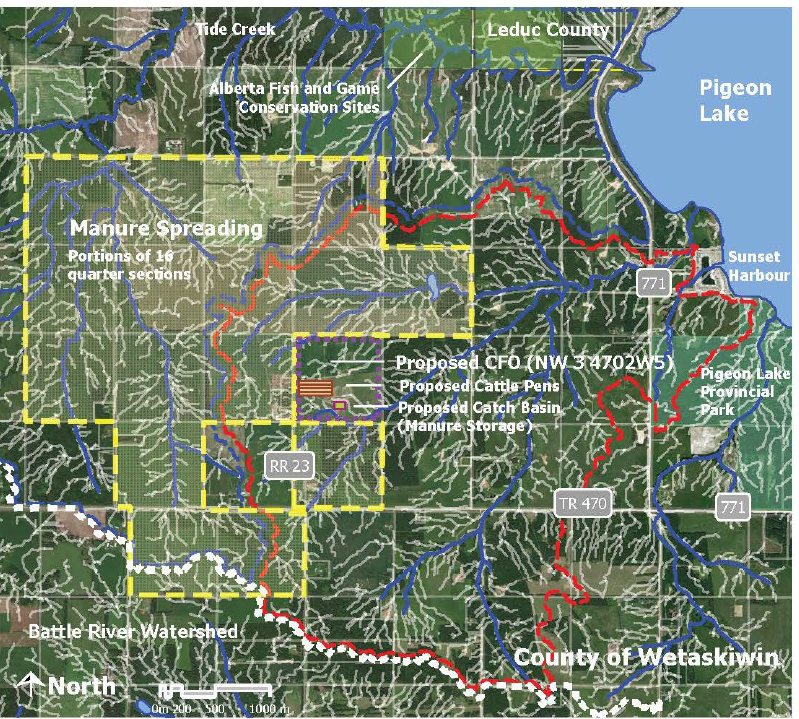A proposed industrial-sized livestock operation southwest of Edmonton is being met with pushback from residents concerned the project could jeopardize their property values and the local ecosystem.

Last month, some were notified of an application by livestock producer G & S Cattle Ltd., to construct a new confined feeding operation (CFO) that would hold up to 4,000 cattle just a few kilometres west of Pigeon Lake.
On April 6, community members rented a hall to gather and share concerns over the proposal, ranging from odour nuisances to potential for ground and surface water contamination.
“It’s very emotional for everybody. That’s probably why we got such a big turnout,” said Ed Buczny, who organized the gathering.
The project would be located adjacent to an existing commercial feedlot of 1,500 cattle operated by the same applicant.
There was a belief amongst those in attendance that the current feedlot was the source of water pollutants in the area, though Global News could not independently verify these claims.
“The biggest concern, probably for everybody in there, is the lake,” Buczny said. “For myself, it’s groundwater (and) it’s what my place is gonna be worth if they put it in — and the smell.”
Testing shows troubling contaminant levels: watershed association
The Pigeon Lake Watershed Association (PLWA) has been conducting testing in the area for years. The group said contaminants from manure produced by cattle seep into the soil and run off in creeks and streams which ultimately end up in Pigeon Lake.
PLWA executive director Catherine Peirce said recent sampling suggests phosphorus levels are 10 times higher than they were in 2013, the last time a major government study on Pigeon Lake was conducted.
Peirce worries if the new CFO is approved and built, the land will not be able to filter the extra nutrients.
“If we add more nutrients in the watershed, we will end up with algal blooms and that will affect the economy,” she said.
Pinpointing source of contamination can be ‘tricky,’ says expert
Pigeon Lake, a popular summer beach destination for Albertans, has been the subject of many blue-green algae public health warnings over the last decade. In July 2021, Alberta Health Services issued a warning for Pigeon Lake about “fecal bacteria” at a local beach.
The biggest concern is phosphorus, according to the Alberta Lake Management Society, which can be both external and internal.
READ MORE: Fecal bacteria leads to advisories at multiple Alberta lakes, including Wabamun and Pigeon
Trying to answer the source of external phosphorus can be tricky, executive director Bradley Peter said. He noted that the data that exists right now isn’t specific enough to pinpoint one source for the problem.
“The reality is we need to be thinking of cumulative impacts when we allow or don’t allow development to occur with any lake watershed,” Peter said.
- High benzene levels detected near Ontario First Nation for weeks, residents report sickness
- Enter at your own risk: New home security camera aims paintballs at intruders
- Fishing vessel with crane, net arrives in Zeballos for orca calf rescue
- Beijing orders Apple to pull WhatsApp, Threads from its China app store
“I think, at the end of the day, we know these developments are not going to improve water quality, so I can certainly understand the frustration of residents.”
County supports application, understands resident concerns
The County of Wetaskiwin has no jurisdiction over CFOs but is certainly hearing about resident frustration.
“We’ve been receiving numerous emails,” Reeve Josh Bishop said. “They’re from many stakeholders, residents, and other (village and municipal) councils among the lake.”
The county is in favour of the application being approved. Bishop said having a CFO in the area will improve provincial oversight and scrutiny. For example, the application must include a proposal for a catch basin where surface water from the cattle pens can drain.
“Being a CFO, (the applicant) will be required to adhere to all the restrictions put in place. Right now, they wouldn’t have too many of those,” Bishop said.
G & S Cattle owner Greg Thelan declined an interview request but provided a statement to Global News.
“We are currently applying for an expansion on our ranch. There seems to be a lot of concern but not a lot of questions, only statements,” the statement reads in part.
“…Our goal is to stay environmentally sustainable. The concerns of water contamination, and depleting water supply, and manure application are all more than covered by the (Natural Resource Conservation Board) NRCB.”
The NRCB is a regulatory body that operates at arm’s length from the provincial government and reports to the Ministry of Environment.
In 2021, the group received 161 applications for CFOs in Alberta. The NRCB said 107 were approved, 44 were withdrawn, three were denied and two were approved following a board review.
People frustrated by process
Only residents considered to be “directly impacted” were notified of the application on March 10. According to provincial legislation, the NRCB is only required to notify residents who live within 1.5 kilometres of the proposed project boundaries. The deadline for those residents to submit statements of complaint was April 7.
“Three weeks to respond to something of this magnitude is not enough,” said Gloria Booth, who has lived in the county for 14 years.
“This is just not morally or ethically correct.”
Buczny thinks the notification range is too limited.
“It’s not just the people within 1.5 kilometres. It’s all the people around the lake,” he said. “Businesses, cottage owners — everything. They should all be part of this process.”
An NRCB spokesperson said affected parties can request a review of the decision, even after approval.
There’s no timeline for a decision, but the NRCB said officers “strive to process applications within 65 workings days” from application completion.






Comments